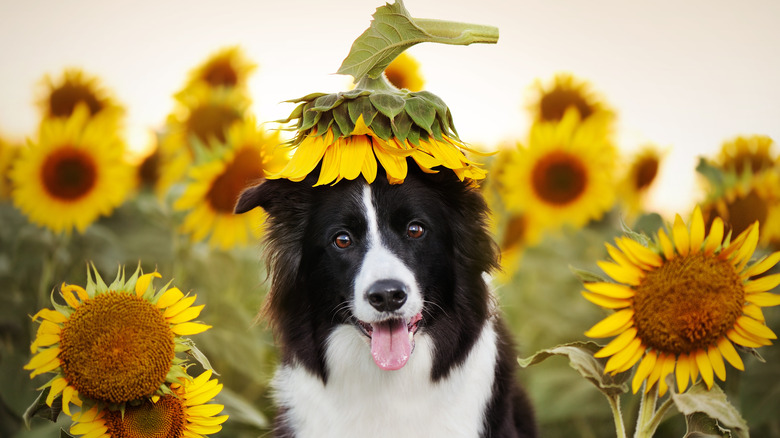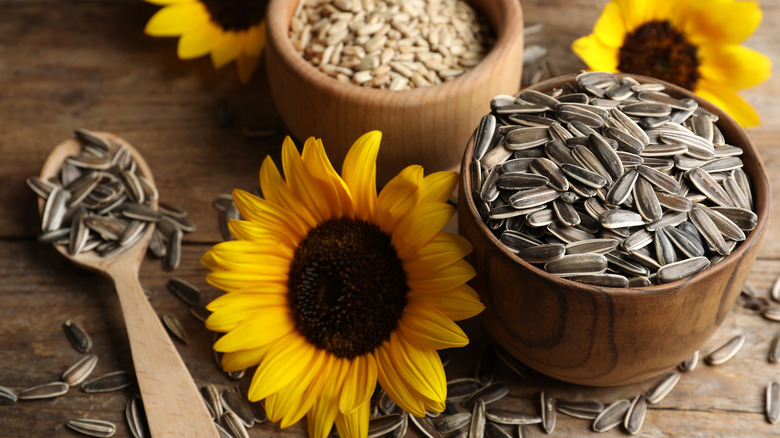What Is The Best Time Of Year To Plant Sunflowers?
Tall, strong, bright, and happy — what's not to love about sunflowers? Growing up to 10 feet tall, the common sunflower (Helianthus annuus) is native to the U.S. and can live in USDA zones 2 through 11 (via Missouri Botanical Garden). That's such a wide range that, with the exception of those living in northern Canada, Alaska, and Hawaii, almost everyone in North America can enjoy growing these jaw-dropping beauties. With over 150 varieties to choose from, it certainly won't be difficult to find a stunning sunflower to brighten your property. The hardest part will be paring it down to one or two.
The state flowers of Kansas are fast growers with seeds that will lure a slew of chirping birds to the garden. Given the right conditions upon landing, you might even find seedlings growing below a bird feeder containing the seeds in its mix. Sunflowers will tolerate less-than-ideal water and soil conditions; however, as their name aptly suggests, plants must receive entire days of full sun exposure to thrive. This is so apropos that the genus Helianthus comes from the Greek words for sun (helios) and flower (anthos). Our sincere condolences go out to the few who cannot grow them in those hottest and coldest places, but for the rest of us, let's get to planting!
Plant seeds directly into the garden in mid to late spring
With sunflowers, you can start seedlings indoors or purchase young plants from a nursery, but you don't really have to worry about either of those options. These mighty flowers will grow just fine from seeds sown directly into the garden, notes the Empress of Dirt; the key is timing. First and foremost, you've got to wait until well after the final frost has passed. The temperature of the soil (not the air) needs to be at least 55 degrees Fahrenheit, although your sprouting seeds will fare much better if it's in the 70s. On the off chance that a late-season cold front is passing through after you've sown the seeds, cover the ground overnight to protect it and them from the frigid air. Then, uncover everything the next morning so it all gets warmed up by the sun.
Gardeners at Little Yellow Wheelbarrow advise that some sunflower seeds can be sown as late as July. So if you have a variety that only takes an average of 55 days to grow to full size and bloom, you might be able to plant them mid-summer, which would offer a wash of color for a vivid autumn garden. For this to work, though, you'll need to understand when the first frost is likely to occur in your area and then work backward from there to figure out the best time.
What to know about sunflower seeds
If you've decided sunflowers are a must-have for your front yard (and why wouldn't you?), here's what you need to know about the seeds. Due to the sheer volume of available varieties, you're almost guaranteed to find a cultivar that will feel right at home where you live. Johnny Seeds explains that there are single-stem and branching sunflowers. Single-stem varieties do not have pollen. Interestingly, they still contain nectar and will attract and feed pollinators. A single-stem cultivar will only produce one thick-stemmed flower for each seed planted, so in order to have a constantly blooming patch, you'll need to keep sowing seeds over the course of the season.
Branching varieties come in a broader range of colors, including unusual shades of bronze, chocolate, and burgundy. Shorter, weaker stems will produce multiple blooms, but these varieties take longer to grow, affecting when you plant your initial crop and how long you have to enjoy them before the temperatures drop and the first frost sets in.
Before you run out to the grocery store for a tasty snack that you plan to half-eat and half-spread throughout your garden, remember that much of that flavor comes from roasting and salting. You won't get any flowers from those, but the fresh, unsalted seeds are plantable (via Suave Yards). Of course, you can also support your local nursery or order from a seed catalog.


